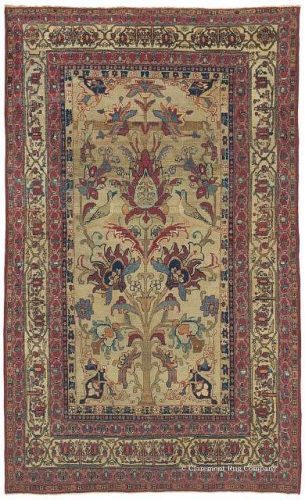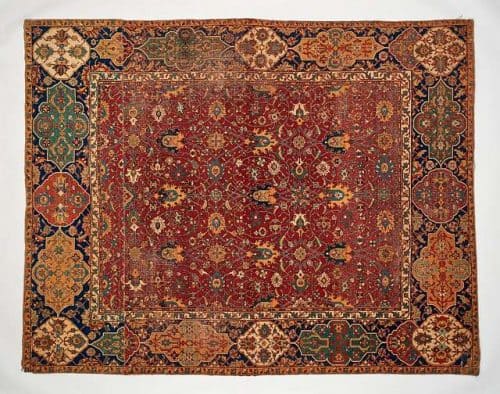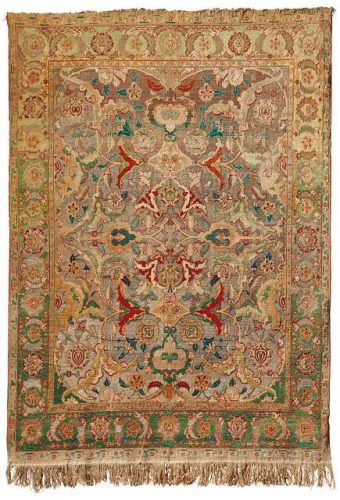When it comes to the world of art collecting, nothing quite matches the allure of the most expensive carpets ever sold.

These masterpieces with stories that stretch across centuries and continents combine exquisite craftsmanship, historical intrigue, and jaw-dropping prices that leave even the most seasoned collectors doing a double take.
So, let’s explore the luxurious world of these textile treasures – the world’s most expensive carpets -and discover why collectors are willing to drop millions on these extraordinary pieces.
The $33 Million Masterpiece: The Clark Sickle-Leaf Persian Carpet
Let’s start with the reigning champion of carpets, the Clark Sickle-Leaf Persian Carpet. When this 17th-century beauty went under the hammer at Sotheby’s for a jaw-dropping $33 million, it blew past expectations. Why? Well, aside from being a masterpiece of Safavid-era craftsmanship, it’s one of the few surviving examples of a specific design motif: the sickle-leaf pattern. The intertwining leaves and floral motifs, all in striking reds, blues, and greens, create a sense of movement and life that makes this a dynamic piece of art.
This Persian wonder also boasts impeccable provenance, having been part of the esteemed collection of William A. Clark, an industrialist with a sharp eye for art. It’s not just the rarity and beauty that made this carpet a $33 million sensation; it’s the story it tells of Persian artistry at its peak.
The Pearl Carpet of Baroda: $5.45 Million of Royal Opulence
Now, if the Persian carpets feel a bit too classic for your tastes, how about something with a little extra bling? Enter the Pearl Carpet of Baroda. This 19th-century Indian treasure sold for a cool $5.45 million at a Sotheby’s auction, and believe me, it’s worth every penny. Commissioned by the Maharaja of Baroda, this isn’t just a carpet; it’s a royal statement of luxury and extravagance.
What makes this piece stand out? For starters, it’s covered in pearls—over two million Basra pearls, to be exact. Add to that rubies, emeralds, and diamonds, all sewn into an intricate floral pattern, and you’ve got a carpet fit for a king (or, in this case, a maharaja). The story goes that this carpet was intended as a gift for the Prophet’s Tomb in Mecca, but it never made it there. Instead, it became one of the most famous examples of Indian artistry in the 19th century, blending Islamic and Indian design influences into a glittering, unforgettable masterpiece.
The Kirman Vase Carpet: A $1.5 Million Botanical Dream
Heading back to Persia, we find the Kirman Vase Carpet, a 17th-century wonder that sold for $1.5 million. Now, this carpet is famous not just for its price as one of the most expensive carpets but for the sheer beauty of its design. The “vase” motif is what sets it apart—delicate floral patterns bursting from intricately woven vases create a tapestry that feels alive with nature’s bounty. The Kirman region was known for producing some of the finest carpets in history, and this particular piece is a shining example of why.
With its finely spun wool and natural dyes, this carpet has managed to maintain its vibrant colours over the centuries. The craftsmanship is undeniable, with each knot painstakingly tied to form a complex and harmonious design. For art collectors, this is the kind of piece that transcends function – it’s a botanical masterpiece that has survived hundreds of years.
The Louis XV Savonnerie Carpet: French Royalty for $4.4 Million
What if your taste leans toward French sophistication? The Louis XV Savonnerie carpet, created in 18th-century France, could make your heart skip many a beat. Fetching $4.4 million at auction, this opulent carpet was woven in the prestigious Savonnerie workshops, which were originally established to produce carpets for the royal palaces of Louis XIV. By the time Louis XV ascended the throne, these carpets were symbols of royal prestige, known for their lush textures and vibrant floral designs.
This particular carpet is a riot of blooming flowers, scrolling vines, and ornate borders, all woven in the rich palette that typifies the Rococo period. Imagine the salons of Versailles, where French aristocrats would gather, with this stunning carpet anchoring the room. Is it any wonder that it holds the tag as one of the most expensive carpets in the world?
Edmond J. Safra’s Safavid Carpet: A $7.7 Million Slice of Persian History
If you’re a collector looking for something with a bit more grandeur, look no further than Edmond J. Safra’s Safavid Carpet. This 16th-century Persian treasure sold for $7.7 million, and for good reason. The Safavid period was the golden age of Persian carpet-making, and this piece is a perfect example of the era’s sophistication. With its intricate arabesques and floral motifs, all set against a backdrop of deep reds and blues, the carpet feels almost regal.

This particular carpet was part of the esteemed collection of Edmond J. Safra, a banker and philanthropist with a deep appreciation for fine art. Owning a Safavid carpet, one of the world’s most expensive carpets is like holding a piece of history in your hands!
Polonaise’ Silk and Metal-Thread Carpet: $790,000 Worth of Glamour
If you’re a Collector looking for something truly unique, how about a carpet that incorporates silk and metal threads? The ‘Polonaise’ carpets, made in 17th-century Persia, are the epitome of luxury. One of these remarkable pieces recently fetched $790,000 at auction, and it’s easy to see why. Woven with shimmering silk and actual silver and gold threads, these carpets were crafted for the elite—European nobility who had an insatiable appetite for Persian luxury goods.

The metallic threads catch the light in a way that’s nothing short of magical, giving the carpet an otherworldly glow. Owning a ‘Polonaise’ carpet is like owning a piece of wearable art—even if it’s on your wall or vault.
The Navajo Blanket: $1.5 Million of Native American Heritage
Switching gears from the palaces of Persia and India, let’s head to the American Southwest, where a humble 19th-century Navajo blanket shocked the auction world by selling for $1.5 million. Unlike the elaborate designs of Persian or Mughal rugs, Navajo textiles are known for their simplicity and symbolism. The blanket, a chief’s first-phase piece, features bold stripes and geometric shapes, woven from hand-spun wool in a deep red and dark blue palette.
What makes this particular piece so special is its rarity. Navajo blankets of this calibre are incredibly scarce, and they represent a rich tradition of Native American craftsmanship. The sale of this blanket highlighted the growing recognition of Indigenous art in the fine art world—a reminder that sometimes, less is more.
The Mughal ‘Star Lattice’ Carpet: $2 Million of Indian Grandeur
For those with a taste for Mughal luxury, the ‘Star Lattice’ carpet is an Indian masterpiece that commands attention—and a $2 million price tag. This exquisite carpet was created during the height of the Mughal Empire when art and craftsmanship flourished under the reign of Emperor Akbar.
The design is a stunning interplay of interlocking stars and floral motifs, woven in a rich palette of deep reds, blues, and golds. Mughal carpets are celebrated for their intricate designs, which combine Persian and Indian influences, and the ‘Star Lattice’ is no exception. With its regal history and impeccable craftsmanship, it’s a favourite among collectors who appreciate both its beauty and its cultural significance.
The Final Knot
Whether it’s the luxurious Pearl Carpet of Baroda, shimmering with jewels, or the minimalist beauty of a Navajo blanket, these carpets represent the pinnacle of craftsmanship and artistry. For collectors, they are more than just investments—they’re pieces of history, woven into every knot and thread.
From the royal courts of France and Persia to the sweeping deserts of the American Southwest, these carpets tell stories of the cultures and people who created them. And while their price tags may make headlines, it’s their beauty, history, and craftsmanship that truly make them priceless.
Owning one of these carpets isn’t just about owning a piece of art—it’s about holding a piece of history, a tangible connection to the artisans who spent years bringing these masterpieces to life. And in a world where fast fashion and mass production dominate, there’s something undeniably special about owning something so rare, so timeless, and so exquisitely crafted.
FAQs – Fascinating Facts About the World’s Most Iconic Carpets
What is the oldest surviving carpet in the world?
The Pazyryk carpet, unearthed in 1947 from a Scythian tomb in Siberia, holds the title of the oldest surviving carpet. This ancient marvel is over 2,000 years old, with historians believing that carpet-making may have begun as early as 7000 BC.
Which carpet holds the record for being the largest handmade in the world?
The world’s largest handmade carpet is the Qasr al-Alam carpet from Iran, stretching beyond the size of a football field. Its immense scale is a testament to the craftsmanship and dedication of Iranian weavers.
What is the most prestigious Indian hand-knotted rug?
The Pearl Carpet of Baroda, commissioned in 1865 for the Prophet Muhammad’s mausoleum in Medina, is regarded as one of the finest examples of Indian hand-knotted rugs. This extraordinary piece features a silk and deer hide base adorned with millions of Basra pearls, rubies, emeralds, and other precious stones.
Why is the colour red so prominent in Persian and Oriental carpets?
Red, a popular colour in Persian and Oriental carpets, carries deep symbolism. It represents courage, beauty, and power, infusing these rugs with a sense of strength and elegance.
Are there carpets tied to historical events?
Indeed, several carpets are linked to significant historical moments. One such example is the “Spring Time of Khosroe,” a Persian masterpiece made of silk and jewels. It was so valuable that when stolen, it was cut into pieces and distributed as war spoils, cementing its place in history.
Why is the preservation of the Pazyryk carpet so unique?
The Pazyryk carpet, discovered in a frozen burial mound in the Pazyryk Valley, owes its incredible preservation to ice. Encased in permafrost for centuries, the carpet was shielded from decay and environmental damage, allowing it to remain in astonishing condition for modern historians to admire.
Read More: Latest



